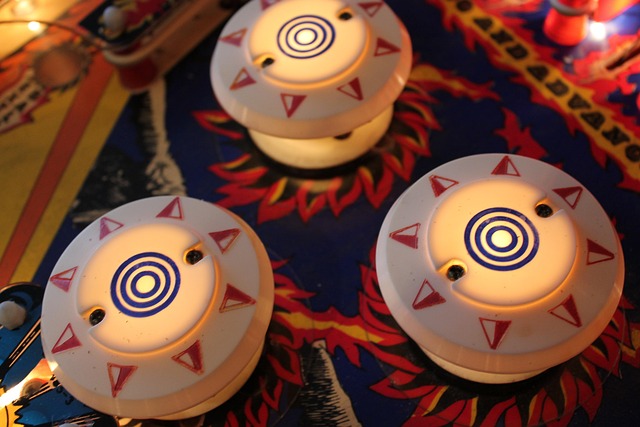Below is our definitive list of slang and technical terms related to pinball machines, covering gameplay, mechanics, design, components, and the cultural aspects of pinball. The list includes terms used in both classic and modern pinball, as well as colloquial expressions from pinball communities, arcades, and competitive play. Pinball has a unique lexicon that reflects its mechanical and electronic evolution, from early electro-mechanical machines to modern solid-state and digital designs. This list draws on the rich history of pinball and incorporates relevant terms from the arcade context where applicable.
A
- Add-a-Ball: A feature or game mode allowing players to earn extra balls instead of free games, common in older machines or during specific modes.
- Apron: The flat, decorated area below the playfield, often displaying game rules, scoring, or artwork.
- Attract Mode: A looping display of lights, sounds, or animations when the machine is idle, designed to draw players.
- Auto-Launch: A mechanism that automatically shoots the ball into play after pressing a button, common in modern machines.
B
- Backbox: The vertical section at the top of the machine housing the score display, lights, and sometimes additional playfield features.
- Backglass: The decorated glass panel in the backbox, featuring game-themed artwork, scores, or animations.
- Ball Lock: A feature where a ball is captured or held on the playfield to enable multiball modes.
- Ball Save: A temporary period after a ball is launched or drains where it’s returned to play without losing a ball, often activated by a feature or setting.
- Ball Shooter: The plunger or mechanism used to launch the ball onto the playfield, either manual or auto-launched.
- Banana Shot: A curved or arcing shot, often unintentional, caused by the ball’s spin or playfield geometry.
- Bang Back: A technique where a player forcefully tilts or lifts the machine to prevent a ball from draining, often risking a tilt penalty.
- Bumper: An active playfield component (e.g., jet bumper or pop bumper) that propels the ball when hit, adding points and randomness.
C
- Captive Ball: A ball constrained to a specific area of the playfield, used as a target to score points or trigger features.
- Combo: A sequence of shots executed in quick succession, often rewarded with bonus points or multipliers in modern machines.
- Co-op Mode: A multiplayer mode where players take turns on the same ball to achieve shared goals, seen in some modern pinball games.
- Credit: A game earned by inserting coins or tokens, or awarded for high scores or special achievements.
D
- Dead Flip: A technique where a player lets the ball bounce off a flipper without flipping, often to control its trajectory or avoid a risky shot.
- Death Save: An advanced technique where a player nudges the machine to save a ball draining between flippers, often by tilting it slightly.
- Diverter: A mechanical gate that redirects the ball to different paths or ramps based on game conditions.
- Dot Matrix Display (DMD): A pixelated display in the backbox used for scores, animations, and game information, introduced in the 1990s.
- Drain: When the ball falls out of play, typically between the flippers or down an outlane, ending the ball’s turn.
- Drop Target: A target that drops below the playfield when hit, often used to unlock features or score points.
E
- Electro-Mechanical (EM): Older pinball machines using mechanical relays and switches instead of solid-state electronics, common pre-1980s.
- End-of-Ball Bonus: Points awarded at the end of each ball based on accumulated achievements, such as completed modes or targets hit.
- Extra Ball: An additional ball awarded for reaching a score threshold, hitting specific targets, or completing modes.
F
- Flipper: The player-controlled paddles used to hit the ball and keep it in play, typically located at the bottom of the playfield.
- Flipper Gap: The space between flippers, a critical factor in ball control and difficulty.
- Free Game: A game awarded for achieving a high score, special combination, or match feature at the end of a game.
- Frenzy: A timed mode where rapid hits to specific targets (e.g., bumpers) yield escalating points, common in modern machines.
G
- Gobble Hole: A hole on the playfield that swallows the ball, often ending the ball or awarding significant points.
- Grand Champion: The highest score recorded on a machine, typically displayed during attract mode.
H
- Habitrail: A clear plastic or metal tube guiding the ball along a path, often used for ramps or return lanes.
- High Score: The top score(s) recorded on the machine, often allowing players to enter initials.
- Hurry-Up: A timed mode where players must hit a specific target or shot to collect a rapidly decreasing point value.
I
- Inlane: A lane that feeds the ball back to the flippers from the playfield’s sides, often with rollovers for scoring.
- Insert: A lit or unlit panel on the playfield indicating targets, modes, or scoring opportunities, often embedded in the surface.
J
- Jackpot: A high-value point award, often earned during multiball or specific modes, e.g., hitting a ramp repeatedly.
- Jet Bumper: Another term for pop bumper, a circular component that propels the ball randomly when hit.
K
- Kickback: A mechanism that returns a ball to play from an outlane, activated by prior achievements or switches.
- Kickout Hole: A hole that captures the ball temporarily before ejecting it back into play, often tied to scoring or modes.
L
- Lane Change: A feature allowing players to shift lit lanes (e.g., inlanes or outlanes) using flipper buttons, often to complete sets or avoid drains.
- Light Show: A coordinated display of lights during attract mode or specific game events, enhancing visual appeal.
- Loop: A ramp or path that allows the ball to travel in a continuous circuit, often for combos or jackpots.
M
- Match: A feature at the end of a game where a random number is displayed; if it matches the last digits of the player’s score, a free game is awarded.
- Mini-Playfield: A smaller, separate playfield with its own flippers or targets, often elevated or recessed, e.g., in Twilight Zone’s “The Power.”
- Mode: A temporary game state with specific objectives or rules, activated by hitting certain targets or shots.
- Multiball: A mode where multiple balls are in play simultaneously, often triggered by locking balls or completing sequences.
N
- Nudge: A gentle push or tilt of the machine to influence the ball’s path, requiring skill to avoid a tilt penalty.
O
- Orbit: A shot that sends the ball around the playfield’s perimeter, often via ramps or lanes, typically for high points.
- Outlane: The lanes on either side of the playfield leading to the drain, often with scoring opportunities or kickbacks.
P
- Pin: Slang for a pinball machine, commonly used in arcade culture.
- Playfield: The main surface where the ball moves, containing flippers, bumpers, ramps, and other features.
- Plunger: The manual device (spring-loaded or knob) used to launch the ball onto the playfield.
- Pop Bumper: A circular, active component that propels the ball and scores points when hit, also called jet bumper.
- Post: A vertical pin or rubber stopper used to guide or block the ball, often adjustable for difficulty.
R
- Ramp: An elevated path that the ball travels up, often leading to other playfield areas or scoring opportunities.
- Replay: A free game awarded for reaching a score threshold, set by the operator or game design.
- Rollover: A switch embedded in the playfield that scores points or activates features when the ball rolls over it.
- Rubber: The elastic bands or rings around posts, bumpers, or flippers that affect ball bounce and speed.
S
- Saucer: A shallow hole or depression that captures the ball briefly before kicking it out, often tied to scoring or modes.
- Shooter Lane: The channel where the ball is launched by the plunger, guiding it to the playfield.
- Skill Shot: A specific shot made immediately after launching the ball, often yielding bonus points or rewards.
- Slam Tilt: A severe tilt caused by excessive force (e.g., lifting or hitting the machine), ending the game and potentially voiding credits.
- Solenoid: An electromagnetic coil used to power components like flippers, bumpers, or kickouts.
- Spinner: A rotating target that scores points as the ball spins it, often placed in lanes or orbits.
- Stand-Up Target: A flat, vertical target that scores points or triggers features when hit by the ball.
- Stopper: Another term for a post, used to block or guide the ball.
T
- Tilt: A penalty triggered by excessive nudging, disabling flippers and other active components for the current ball.
- Tilt Bob: A pendulum sensor in the machine that detects excessive movement, triggering a tilt.
- Topper: A decorative or functional element mounted on top of the backbox, often with lights or animations in modern machines.
- Trap: A technique where the ball is caught and held on a raised flipper, allowing the player to aim or plan the next shot.
V
- Video Mode: A software-based mini-game displayed on the DMD or LCD, controlled by flipper buttons, common in modern pinball.
- Wizard Mode: An advanced, high-scoring mode unlocked after completing major game objectives, e.g., “Lost in the Zone” in Twilight Zone.
W
- Wizard: A highly skilled pinball player, often recognized in competitive circles.
Notes
- Historical Context: Terms like “electro-mechanical” and “add-a-ball” are tied to older machines, while “DMD” and “video mode” reflect modern solid-state designs.
- Cultural Slang: Terms like “pin” and “wizard” are part of pinball’s arcade culture, especially in competitive scenes.
- Game-Specific Terms: Some terms (e.g., “wizard mode”) are specific to modern machines with complex rules, while others (e.g., “gobble hole”) are more common in older designs.
- Competitive Play: Terms like “1GC” (one-game clear, completing a game without tilting or losing all balls) are emerging in competitive pinball but are less common.

